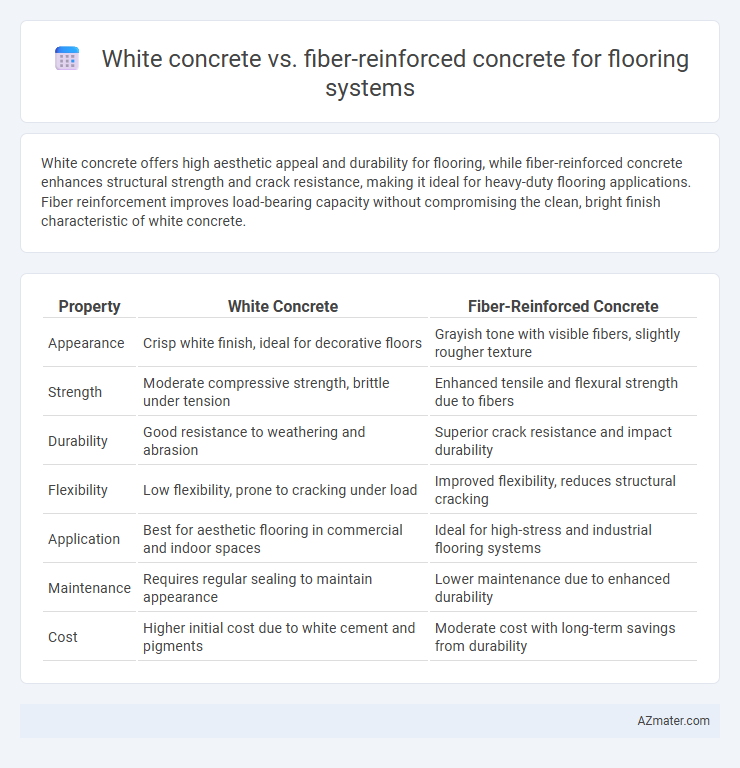White concrete offers high aesthetic appeal and durability for flooring, while fiber-reinforced concrete enhances structural strength and crack resistance, making it ideal for heavy-duty flooring applications. Fiber reinforcement improves load-bearing capacity without compromising the clean, bright finish characteristic of white concrete.
Table of Comparison
| Property | White Concrete | Fiber-Reinforced Concrete |
|---|---|---|
| Appearance | Crisp white finish, ideal for decorative floors | Grayish tone with visible fibers, slightly rougher texture |
| Strength | Moderate compressive strength, brittle under tension | Enhanced tensile and flexural strength due to fibers |
| Durability | Good resistance to weathering and abrasion | Superior crack resistance and impact durability |
| Flexibility | Low flexibility, prone to cracking under load | Improved flexibility, reduces structural cracking |
| Application | Best for aesthetic flooring in commercial and indoor spaces | Ideal for high-stress and industrial flooring systems |
| Maintenance | Requires regular sealing to maintain appearance | Lower maintenance due to enhanced durability |
| Cost | Higher initial cost due to white cement and pigments | Moderate cost with long-term savings from durability |
Introduction to White Concrete and Fiber-Reinforced Concrete
White concrete is a specialty construction material known for its high reflectivity, aesthetic appeal, and durability used in flooring systems where visual impact and light enhancement are critical. Fiber-reinforced concrete incorporates synthetic or steel fibers to improve tensile strength, crack resistance, and overall toughness, making it ideal for heavy-duty flooring applications requiring enhanced structural performance. Both materials offer unique benefits, with white concrete emphasizing appearance and reflectivity, while fiber-reinforced concrete prioritizes mechanical strength and durability.
Composition Differences: White Concrete vs Fiber-Reinforced Concrete
White concrete consists primarily of white Portland cement, fine and coarse aggregates, and water, resulting in a smooth, aesthetically appealing finish ideal for decorative flooring applications. Fiber-reinforced concrete incorporates synthetic or steel fibers dispersed throughout the mix, enhancing tensile strength, crack resistance, and durability in high-traffic flooring systems. The key compositional difference lies in the inclusion of fibers, which significantly improve mechanical performance compared to the more uniform matrix of white concrete.
Aesthetic Qualities for Flooring Applications
White concrete offers a clean, reflective surface ideal for creating bright, modern flooring with a uniform appearance that enhances natural and artificial lighting. Fiber-reinforced concrete improves surface durability and crack resistance while maintaining a versatile texture that can be customized with various finishes and coloring techniques for aesthetic enhancement. The choice between white concrete and fiber-reinforced concrete for flooring depends on desired visual effect and performance requirements, balancing brightness and sleekness with strength and texture variety.
Mechanical Strength and Durability
White concrete offers moderate mechanical strength and excellent durability, primarily used for aesthetic flooring applications where color retention is important. Fiber-reinforced concrete significantly enhances mechanical strength by reducing cracking and improving tensile and flexural strength, resulting in superior durability under heavy load and impact conditions. For high-performance flooring systems, fiber-reinforced concrete provides better structural integrity and longer service life compared to standard white concrete.
Flexural and Tensile Performance Comparison
White concrete offers moderate flexural strength and tensile capacity suitable for aesthetic flooring applications, whereas fiber-reinforced concrete (FRC) significantly enhances flexural toughness and tensile resistance due to the inclusion of steel, glass, or synthetic fibers. FRC exhibits improved crack control and post-cracking behavior, resulting in superior durability and load distribution under bending stresses. The enhanced tensile performance of FRC makes it preferable for high-traffic or industrial flooring systems demanding greater structural resilience compared to conventional white concrete.
Installation Process and Workability
White concrete offers a smooth and aesthetically pleasing finish ideal for visible flooring but requires precise mixing and curing to prevent discoloration and cracking during installation. Fiber-reinforced concrete enhances workability by reducing segregation and improving plasticity, allowing easier placement and better surface consolidation, especially in thin slabs or complex shapes. Both materials demand skilled labor for optimal results, yet fiber reinforcement typically accelerates the installation process by minimizing finishing defects and reducing shrinkage-related issues.
Maintenance and Longevity of Flooring Systems
White concrete offers high reflectivity and aesthetic appeal but may require frequent maintenance to address surface wear and potential staining, impacting its long-term durability. Fiber-reinforced concrete enhances tensile strength and crack resistance, significantly reducing maintenance needs and extending the flooring system's lifespan under heavy traffic conditions. Choosing fiber-reinforced concrete ensures improved structural integrity and longevity, minimizing repair costs over time compared to traditional white concrete floors.
Cost Considerations and Economic Impact
White concrete typically incurs higher initial costs due to the use of pure white cement and specialized aggregates, impacting overall project budgets. Fiber-reinforced concrete, though slightly more expensive upfront than standard concrete, offers enhanced durability and reduced maintenance expenses, leading to long-term economic benefits in flooring systems. Evaluating life-cycle costs shows fiber reinforcement can mitigate repair costs and extend flooring lifespan, making it a cost-effective choice despite higher immediate investment.
Sustainability and Environmental Impact
White concrete offers high solar reflectance, reducing urban heat island effects and lowering energy consumption for cooling, which contributes to sustainability in flooring systems. Fiber-reinforced concrete enhances durability and extends the service life of floors by minimizing cracking and maintenance needs, thereby reducing resource consumption and environmental impact over time. Combining these materials can optimize both environmental benefits and structural performance for eco-friendly flooring solutions.
Best Use Cases for Each Concrete Type in Flooring Systems
White concrete is ideal for flooring systems in architectural projects requiring high aesthetic appeal, such as commercial lobbies, retail spaces, and residential interiors with modern design themes, due to its bright, reflective surface and smooth finish. Fiber-reinforced concrete excels in flooring applications subjected to heavy mechanical loads and impact, like industrial warehouses, parking garages, and manufacturing facilities, offering enhanced tensile strength, crack resistance, and durability. Choosing between white concrete and fiber-reinforced concrete depends on whether visual appeal or structural performance is the primary requirement for the flooring system.

Infographic: White concrete vs Fiber-reinforced concrete for Flooring system
 azmater.com
azmater.com